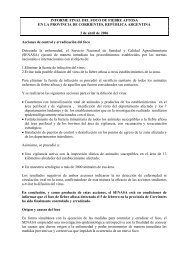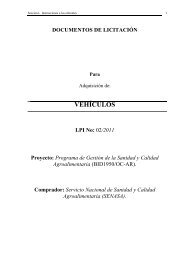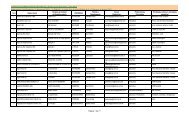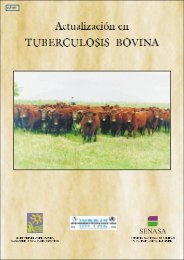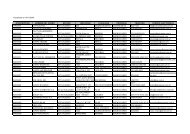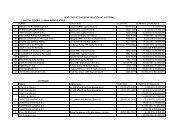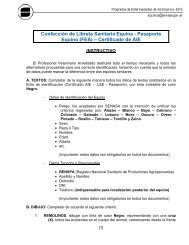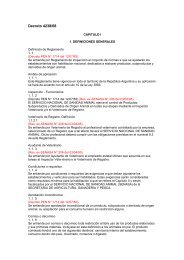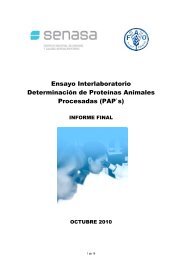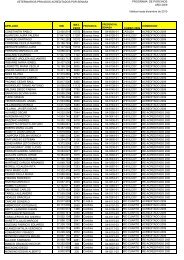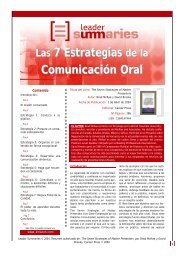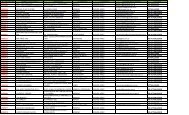PLAN DE TRABAJO PARA LA AUTORIZACION PRE ... - Senasa
PLAN DE TRABAJO PARA LA AUTORIZACION PRE ... - Senasa
PLAN DE TRABAJO PARA LA AUTORIZACION PRE ... - Senasa
- No tags were found...
Create successful ePaper yourself
Turn your PDF publications into a flip-book with our unique Google optimized e-Paper software.
medición de toma de muestras, deberá encenderse nuevamenteel sistema de circulación por media hora más. En caso depersistir la misma, el tratamiento debe ser anulado . Asimismo,si la diferencia es mayor de OCHO (8) gramos/metro cúbico,el tratamiento debe ser anulado en la primer lectura8. PROCEDIMIENTO <strong>PARA</strong> <strong>LA</strong> APLICACIÓN <strong>DE</strong>LTRATAMIENTO <strong>DE</strong> FUMIGACION8.1 Servicio de inspección:8.1.1 El Director Técnico del Centro de Fumigación debetener disponible, diariamente y por escrito, el cronogramatentativo de actividades a desarrollar, con 24 hs. de anticipacion.El mismo deberá ser enviado a APHIS y a la oficina de SENASAcorrespondiente, via correo electrónico/fax. Si fuera necesario seanalizará, modificará y será coordinado con el Inspector delSENASA a cargo.8.1.2 El Inspector del SENASA asignado al Programa deCertificación en origen de arándanos frescos, prestará susservicios en base al cronograma enviado por el Centro deFumigación, mediante solicitud a la oficina de SENASAcorrespondiente8.1.3 El Centro de Fumigación tendrá una tolerancia de hastamedia hora después de la hora solicitada a la Oficina delSENASA para iniciar el tratamiento de fumigación. Finalizadoese lapso, el Inspector del SENASA no está obligado a prestar elservicio de supervisión del mismo.8.1.4 Los costos que genere la operatoria de inspección ysupervisión del SENASA, de acuerdo a la normativa vigente,serán solventados por el Centro de Fumigación.8.2 Aplicación del tratamiento8.2.1 Medición manual de temperaturasEl Inspector SENASA verificará manualmente las temperaturasde pulpa del producto. Para este efecto, los pallets deben estarestibados fuera de la cámara y con una separación tal que permitarealizar el chequeo de temperatura por cualquiera de sus cuatrocostados.8.2.1.1 .- Aquellos pallets con temperatura superior a 21 ºCdeberán ser identificados por el inspector del SENASA con elcorrespondiente Certificado PPQ 535 troquelado (Ver anexo III)y a partir de ese momento estarán aptos para ser tratados.8.2.1.2 Cuando el Centro de Fumigación presente lotes depallets con temperaturas homogéneas, el Inspector de SENASApodrá reducir el número de pallets a ser chequeadosmanualmente de acuerdo a la uniformidad y rango de las lecturasde temperatura que se obtengan.Este procedimiento se discontinuará, en caso de detectarseproductos fríos y calientes destinados a un mismo proceso, sinque haya sido advertido el Inspector SENASA de esta situación.Al preparar el cronograma de trabajo para presentar a SENASA alos efectos de ajustar los horarios de inicios de tratamientos delas distintas cámaras, se debe tener en cuenta que la temperaturade pulpa no debería ser inferior a 21ºC para la hora a la que secitó al Inspector.8.2.1.3 Todas las temperaturas manualmente registradas deberánser corregidas utilizando el factor de corrección que está indicadoen el Certificado de Calibración del termómetro manual, si así(5) grams/cubic meters, in TWO (2) or more of the measuringpoints for taking samples. If the difference persists, thetreatment will be cancelled. Also, if the difference is greaterthan EIGHT (8) grams/cubic meters the treatment will becancelled during the first reading.8. PROCEDURE FOR APPLICATION OFFUMIGATION TREATMENT:8.1. Inspection services:8.1.1. A tentative daily Activity Report in writing will have tobe prepared by the Fumigation Center Technical Counterpartwith a 24 hour advanced notice. The Report will have to be e-mailed or faxed to APHIS and to the corresponding SENASAoffices and, if required will be analyzed, modified andcoordinated by the SENASA Inspector.8.1.2. A SENASA fumigation program of fresh blueberries inorigin Inspector will be assigned only if requested by afumigation center to the corresponding SENASA office.8.1.3. The Fumigation Center will have half an hour toleranceafter their request to the SENASA office to initiate thefumigation process. After that period of time, the SENASAInspector is not obliged to provide any supervision service.8.1.4. In accordance with established norm, all of SENASA’sinspection and supervision costs will be paid by the FumigationCenter.8.2. Treatment procedures:8.2.1. Manual temperature measuringThe SENASA Inspectors will manually verify the pulptemperatures. For this purpose, all pallets will be placed outsidethe chamber with sufficient space between them to permittemperature readings from any of their four sides.8.2.1.1. Those pallets with temperatures higher than 21º will beidentified by the SENASA Inspector with the correspondingPPQ 353 Certificate (See Annex III) and then placed in thefumigation chamber.8.2.1.2. In the case where lots have similar temperatures at theFumigation Center, the SENASA Inspector may reduce thenumber of pallets to be manually checked taking into accountthe uniformity and range of temperature readings.This procedure will be discontinued in case any cold and warmproducts destined to this process are detected, which had notbeen previously notified to the SENASA Inspector.When working schedules are prepared for SENASA to adjusttime schedules for the initiation of treatments in the differentchambers, it should be taken into consideration that at the timethe Inspector is present at the chamber, no pulp temperaturesshould be below 21º.8.2.1.3. If required, all manual temperature readings will becorrected using the correction factor indicated in the manualthermometer Calibration Certificate.



